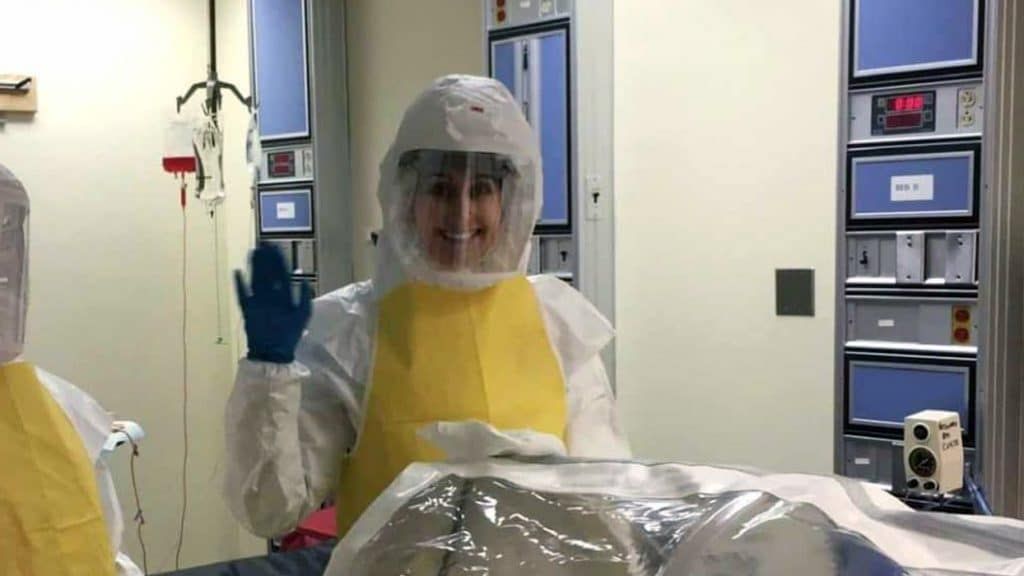Pandemic dispatch: An infection-prevention expert on shortages, misinformation, and health worker strain on the coronavirus front line
By Saskia Popescu | May 8, 2020
 The author during a training on Ebola procedures. Photo courtesy of Saskia Popescu.
The author during a training on Ebola procedures. Photo courtesy of Saskia Popescu.
For the past four months, I’ve had a front row seat to the coronavirus pandemic. Working in a major hospital system, I’ve seen first-hand the issues that have come to define the crisis: the concerns about supplies, the torrent of misinformation, and the critical problem of health care worker exposure to COVID-19. Infection preventionists such as myself work in hospitals to stop the spread of infections among patients, staff, and visitors alike. Despite our training, the coronavirus has tested hospital programs like mine, forcing us to drastically change our daily practices.
I work for a health care system that has several major hospitals and dozens of clinics; I’m part of a team of a dozen diverse and passionate infection preventionists. Programs like mine include nurses, epidemiologists, microbiologists, and people in a variety of other professions that offer critical insights into how diseases are transmitted in health care settings. Fortunately, at my system in Arizona, we had invested in high-consequence disease preparedness. We were closely watching the novel coronavirus outbreak as it began in January to evaluate our ability to surge our capacity and to rapidly identify and isolate patients. We monitored the status of our critical supplies and our infrastructure, including our airborne infection isolation rooms.
We knew it was only a matter of time before a COVID-19 patient showed up at our door. When the first COVID-19 patient was identified in Washington state, we ramped up our efforts to focus more on supplies, screening mechanisms to isolate the sick, communications, and a dozen other pieces that go into preparing a hospital system for an impending epidemic.
The supply chain. Once the epidemic really took off in the United States in March, the reality of the situation set in, and we had to deal with a rapidly changing outbreak that would test our preparation. In pretty short order, public health and health care professionals around the country grew more concerned about supplies of important personal protective equipment. I remember more than one frantic conversation about N95 respirators, the kind of mask that offers strong protection for health care workers. We ended up experiencing a double whammy of manufacturer issues and a global run on supplies. This was the pivotal time when we realized how dependent health care supply chains are on international manufacturers—a precipitous balance.
With so many people hoarding important equipment, the respirators required for COVID-19 patient care quickly became a hot commodity. The strained supplies of masks would soon be accompanied by limited supplies of gowns, disinfecting wipes, and even hand sanitizer.
Before the pandemic, we didn’t always have to be such good stewards of our resources; N95 masks were worn once and thrown away. But given the possibility of a supply shortage, like many hospitals, we evaluated and then rolled out extended use policies created by the federal government, practices that were entirely novel for health care workers and infection preventionists alike as they were developed for a pandemic of the sort we had never experienced. We’ve had to learn to reuse our precious N95 masks, disinfecting them with, yes, UV light. (Good for disinfecting equipment, bad for injecting into your body.)
Misinformation overload. The so-called infodemic—the deluge of information, much of it dubious or false—didn’t spare my line of work. We are constantly being inundated. The infodemic has meant that new studies are being published that are rapidly picked up and sensationalized by news and media sources, amplifying fears among health care workers. Every educational session I did involved time talking to staff about their concerns related to what they were seeing or reading online.
One question that kept coming up regarded a study reporting that SARS-CoV-2, the virus that causes COVID-19, could remain in the air for three hours. Many news sources took this study, which detailed an experiment mimicking aerosol-generating procedures, as an indicator that the tiny aerosolized particles that people emit in breathing and talking contribute to airborne transmission of the disease. This wasn’t the case, and despite the authors of the study pointing this out, I spent a lot of time talking to staff about what the study showed, which actually reinforced what we already had been doing—enhanced respiratory protection during aerosol-generating procedures such as putting someone on a ventilator.
Pushing back against the infodemic and giving staff correct information became just as important as education on personal protective equipment.
Exposure at work. More than 9,000 health care workers had been infected by coronavirus as of mid-April, according to the US Centers for Disease Control and Prevention. When a patient tests positive for COVID-19, we do what’s called an exposure review. That means figuring out all the staff who could have been exposed. We review their interactions with the patient and whether they used personal protective equipment.
Since these reviews can be quite time consuming, we have a small team that mines through the electronic medical record to identify those who we know for certain interacted with the infected patient and who we can reach out to. From this list, we then interview staff by phone to ask about their interaction with the patient and if personal protective equipment was worn to determine if they had a high-risk exposure (i.e., if they had close contact for a prolonged period of time without personal protective equipment, and might need to be quarantined at home).
Sometimes these conversations can be challenging; staffers can be scared or might not remember if they wore a mask during an encounter occurring several days earlier. Thankfully, the universal mask guidelines rolled out in hospitals (which require everyone to wear a mask all the time), helped reduce the volume of staff exposed. Unfortunately, though, this doesn’t diminish the potential for staff to be exposed in the community, which we’re seeing more of.
Working in infection prevention during the pandemic has been like building the bridge as you run across it. We’ve had to rapidly produce process charts, new educational information, practice guidance, and a million other deliverables. From developing and continuously modifying algorithms that guide personal protective equipment usage or patient isolation to making plans for how to manage airflow during surgery on a COVID-19 patient, we are testing and perfecting everything we do in a hospital.
Despite the long hours and the stress, I’m constantly amazed by the people I work with in health care; everyone has chipped in. “All hands on deck” is the motto. And the support we’ve gotten from the community as people have tried to help us with some of the issues we face has been unbelievable. Local breweries even began making alcohol-based hand sanitizer as hospital supplies began becoming stretched across the state.
What the camaraderie and support doesn’t prepare you for, though, is the strangeness of it all. These days at hospitals, elective surgeries are cancelled, and no visitors are allowed in. The hospital has become an eerily quiet space, except, of course, for the COVID-19 units. Those are bustling. Daily temperature and symptom checks are the new norm for the staff. Patients are screened at the entranceway. We all wear masks throughout the day, and meeting size has been reduced to groups of 10 or less, if the meetings happen at all.
I often find myself surprised that people don’t realize that the US health care system is not set up for these events. Preparing for a pandemic is not mandated, and federal funding for enhanced readiness has dwindled over the years. We’ve had to be creative and learn a lot on the fly. Hospital capacity, like other public health resources, is inherently limited, and that’s why the stay-at-home orders and social-distancing restrictions have been so important. Those restrictions have bought us time to catch up.
As those restrictions begin to be rolled back and the economy is slowly reopened, our team is beginning the conversation about sustainable response. If and when a COVID-19 surge returns, how can we respond better?
There is still a lot of work to be done but I am hopeful that if a surge occurs, we’ll be more capable and confident in our response.
Together, we make the world safer.
The Bulletin elevates expert voices above the noise. But as an independent nonprofit organization, our operations depend on the support of readers like you. Help us continue to deliver quality journalism that holds leaders accountable. Your support of our work at any level is important. In return, we promise our coverage will be understandable, influential, vigilant, solution-oriented, and fair-minded. Together we can make a difference.
Keywords: Coronavirus, hospitals, infection prevention
Topics: Disruptive Technologies














